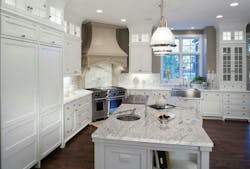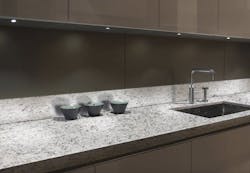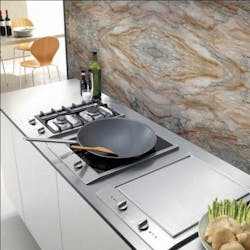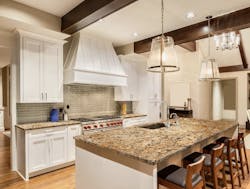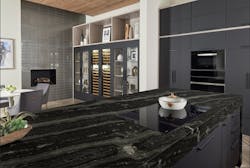What Are the Pros and Cons of Granite Countertops?
Granite has long been one of the most popular kitchen and bath countertop materials, but as the needs of the kitchen change and design aesthetics shift, are they ideal for today’s kitchen?
The National Kitchen and Bath Association’s (NKBA) design trend reports have kept an eye on granite’s decline, but the stone remains the third most popular choice for kitchen projects. In the NKBA’s 2021 Design Trends report, quartz countertops stole the most popular spot—a continuation of quartz’s trajectory since 2018 when it first reached number one.
But when it comes to Houzz’s 2020 Kitchen Trends Study, homeowners chose quartz only 40% of the time, still beating out granite which 28% of homeowners utilized for upgraded countertops.
Despite falling to the wayside, granite remains a strong contender for kitchen countertops. Some designers hate it, but others still widely use it.
Here are some things residential pros can keep in mind when considering granite for their next project.
[ Read More: 6 ALTERNATIVE COUNTERTOP OPTIONS YOU MAY NOT KNOW ]
S F Real Granite by MSI Surfaces
Pros for Granite Countertops
Natural, organic design has quickly emerged as 2021’s hottest design style. Manufacturers of tiles, wallpapers, appliances, plumbing, and more are angling new releases toward the idea of biophilia and wellness.
Since granite is a natural stone, it offers a unique, earthy appearance. And granite truly is unique because no two slabs look the same. This also brings in a wide array of options for granite. Products with an artisan, earthy element are booming in popularity, and granite can fit right into that aesthetic.
Because it is a natural stone, granite also brings high durability and strength to the areas of the home that need it the most. The material is scratch- and heat-resistant and offers protection from staining if it is sealed correctly.
[ Read More: 5 ALTERNATIVES TO CONCRETE COUNTERTOPS ]
Fusion granite by MSI Surfaces
According to HomeAdvisor’s cost data research, homeowners pay between $2,000 and $4,500, with $3,250 being the average for granite countertops, including material and installation. Materials run between $40 to $60 per square foot—but can be even pricier for exotic slabs—and installation typically costs between $35 to $85 per hour. Realtor.com says costs most often fall between $50 to $80 per square foot.
Even if the price is high, it’s arguable that it can be cheaper than many other surfaces in the long run due to its durability. Sometimes granite can last longer than an occupant lives in a home. And there can be a return on investment once a homeowner decides to sell.
Although lighter countertops may be more popular, granite’s thick veins and mix of colors can hide debris and crumbs easier than a white surface.
[ Read More: ONLINE CUSTOM KITCHEN CABINET BRAND SEEKS TO UPEND MARKET ]
Solarius by MSI Surfaces
Cons for Granite Countertops
While the natural aspect of granite countertops can be great for an earthy element, it also means homeowners will have to remain on top of maintenance. Granite countertops are strong and durable as long as it receives sealing each year.
If homeowners are lax in their maintenance, the porous granite can suck up oils, juice, and wine, which will be impossible to remove. Bacteria can also harbor inside granite if not sealed properly. As Americans utilize their kitchens more, there are more chances for accidents to happen. And many homeowners rather not be bothered with any maintenance, reports Realtor.com.
“Zero-maintenance surfacing is a top client request for both kitchen and bath updates,” Young Huh, a New York City–based interior designer told Realtor.com. “They want a surface that captures the drama of natural stone without the constant sealing and upkeep.”
And despite being strong, a heavy pot or pan can crack and chip granite because each slab will have its flaws and imperfections. Sealed granite will never be as strong as its more popular counterpart, quartz.
[ Read More: 2020 COUNTERTOP GUIDE: CONSUMERS FLOCK TO MARBLE LOOKALIKES ]
Agatha Black granite by MSI Surfaces
Arch City Granite & Marble Inc also warns that heavy granite slabs may require extra support for cabinets underneath, which would require more professional help and money.
Granite’s well known characteristics make the material easy to spot. Additionally, the stone has been a top choice for years and it offers a long lifespan, resulting in granite countertops being very common. If a homeowner wants a standout kitchen, this common material may not be the way to go.
When it comes to 2021 kitchen design and beyond, more homeowners and designers opt for “lighter” colors. The NKBA’s 2021 Design Trends report found 58% of designers using lighter surfaces in kitchen countertops and backsplashes. Granite’s organic nature gives it thick, dense, dark veins that will make its own statement and work well for dark countertops, but lighter shades will feature granite’s darker speckles.
"I am not a big fan of granite countertops, as they have a little too much visual movement for me, and I think they can end up overwhelming a kitchen,” Amy Sklar, an L.A.-based interior designer told Real Simple. “Quartz stone tends to have more regular and delicate patterning throughout, which I think looks cleaner and lets the lines of the kitchen come though.”
Many homeowners choose different countertop materials for their kitchen islands now as well, but granite countertops are not finding a place here either. Houzz’s 2021 Kitchen Trends Survey found most homeowners are choosing butcher block or wood slab island countertops.
